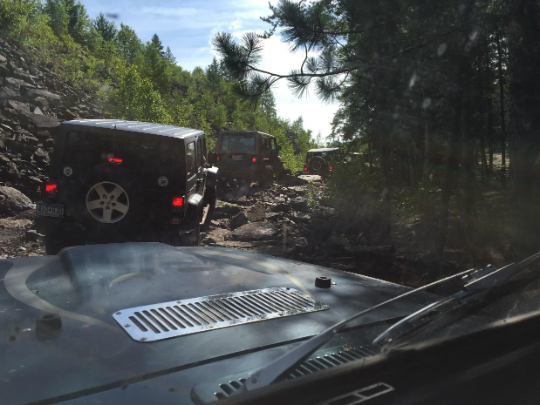Posted on 4/9/2025

Are you new to the world of off-road trail driving? Maybe you just purchased your first Jeep and now you want to see what all the hype is about. Well then, this is the article for you. I’m going to touch on a few key points and share some tips to get you out there having fun on the road less traveled. I’d like to help take some of the frustrations out of your travels and keep you moving on the trail having a great time. Read along and see if you are aware of these tricks for trail driving. On Trail TipsAiring down – This is simply letting air out of your tires to improve ride quality and traction by increasing the footprint of the tire. There is a bit of an art and science to it, but the short answer is getting your tires aired down to the 10-15 PSI range makes a dramatic difference on how the vehicle rides and how much control you will have off-road. See my article &l ... read more
Posted on 4/6/2025

This article might stir up a hornet’s nest of opinions, but it is an important question to consider. Does a person need to return to the dealer to get their vehicle serviced properly? Is there an advantage to dealer service over independent repair facilities? What can I or should I expect from both? What’s in my best interest as a vehicle owner? Today we will answer these questions and more. The opinions in this article will be based on my more than 30 years of experience in the automotive industry working as an automotive technician, parts store manager, business owner, and vehicle owner. We all know what a dealership is, it’s the place where many go to buy a new ride or new to you used vehicle. It’s usually a big place with lots of windows, shiny new vehicles, and some used vehicles. They like to proudly display big well-lit brand specific signs out front. Let’s focus on the service departments of those car dealers. Typically, when you purchase a vehicl ... read more
Posted on 3/25/2025

Recommended Recovery Equipment for Off-Road Adventures It’s time to start thinking about gearing up for summertime adventures. Time to dig out your toys and get them ready for some fun. Maybe you are part of the select few that never put the toys away through the winter or your summer toy is your daily driver. If you wish to seek the trail less traveled, it is a great idea to be prepared for the unexpected. Let’s face it, none of us think we’ll get our rigs stuck or disabled, but sooner or later it is bound to happen. Having the right recovery gear with you can help you get back on the trail safely and successfully. It’s more than just the gear though, it’s about having the right gear and knowing how to use it properly. Nobody wants to get hurt or destroy their rig unnecessarily while they are out having some fun. Take the time to collect the right gear and learn how to use it properly. Today, I’m going to focus on some recommended gear, but I can&r ... read more
Posted on 3/17/2025

Warmer weather is on the way! Soon it will be time for those summer road trips and travel plans you have been thinking about all winter. Before you know it, you’ll be loading up the vehicle, corralling the children, and hitting the road. Are you ready? Is your vehicle ready? Do you know what should be checked before we enter the warm season? Let’s explore what you should look at or have looked at before you take the next summertime road trip. Tires - Cold weather and salty roads are hard on everything, including your tires. Check the tire pressure and fill them with the recommended pressure as stated on the driver’s side door placard. Tire pressures vary depending on the temperature outside. Check the overall condition of your tires. Look for weather cracks in the outer casing and the depth of the tread. The state minimum is 2/32” but we have found that due to the weather extremes and changing road conditions in Minnesota, 4/32” is a real ... read more
Posted on 2/6/2025

Breaker, Breaker Is There Anyone Out There? Since the beginning of motor vehicle travel, people have been looking for good ways to communicate between vehicles while traveling. Driving alongside each other and yelling out the window has its limitations. The US military was one of the first to start using radio communications to speak to troops in moving ships, aircraft, and vehicles. The original equipment was big and bulky, but it worked much better than yelling out the window! Radio communication made its way to civilian use in 1945 when the FCC (Federal Communications Commission) created the Citizen’s Radio Service. The early CB (Citizen Band) radios were UHF around 460 MHz. In 1948 the FCC reallocated the 27 MHz band for citizen use, making it easier and more affordable for individuals to use. The original CBs started out with only 23 channels, and you needed a license operate them. By 1977 the FCC expanded CBs to 40 channels and dropped the need for a license for operation ... read more
Posted on 2/1/2025

What Is a Tune-Up and Why Do I Need One? What do you think of when you are told your vehicle needs a tune-up? Does that mean an oil change? How about spark plugs or a filter? Maybe it means some kind of fuel injector cleaner labeled as “tune-up in a can”, or is it just a good inspection? It’s one of those automotive terms that can mean different things to different people. Let’s look back at what the term historically meant before we look forward to what it means now. Way back at the dawn of the automotive area, the Ford Model T was first unveiled in 1908. It was designed as a cost-effective vehicle that many people could afford. Introduced at $825, and due to the development of the assembly line, the price dropped down to $260 by 1925. These vehicles are simple in design but require significant maintenance to keep them operating at peak performance. With daily, weekly, and monthly maintenance schedules, the vehicle owner got to know their vehicle intimately. I ... read more
Posted on 1/2/2025

What to Know About Lift Kits and Suspension Modifications Is your stock vehicle just begging you for bigger tires and a lifted suspension! I get it. Some vehicles just look wrong when left in stock form. Especially when vehicles with big tires are everywhere once you start looking for them. It seems like it would be an easy thing to order up a lift kit and a set of big tires so you can be the coolest cat on the block! Just Google a lift kit for your truck and many options will likely pop up. Some of those options are much better than others. Do you know what to look for and what to stay away from? Well, you’re in luck because that’s exactly what we are going to talk about here. When you know the right questions to ask, you can ensure that you don’t end up wreaking a perfectly good vehicle and turning it into something you hate to drive. In most cases, vehicle suspension modifications will be required to fit those big tires under the vehicle. Vehicle manufacturers spe ... read more
Posted on 1/2/2025

The Truth About Minnesota Collector Plates Why would you want a collector, pioneer, classic, street rod, or military license plate? To save money on annual tab fees. The tab fee you pay every year is a tax for operating your vehicle on public roads, which is based on the age and value of the vehicle. The tab fees start out high and decrease as the vehicle ages. Collector plates, on the other hand, have a one-time tax fee and don’t require yearly tabs after that point. Each plate has its own specific standards, but all must meet some basic requirements to be eligible for collector plates. The vehicle must be at least 20 years old or of such rarity that they were made in limited quantities. You must own a vehicle registered with regular taxable plates that is available for daily transportation needs. That's really the basic requirements for collector plates. See Minnesota Statute 168.10 for more information. My buddies and/or the DMV people say that "You can only drive m ... read more
Posted on 12/5/2024

Can I Save Money by Fixing My Vehicle at Home? Bob says, “We can fix that wheel bearing next Saturday.” Which could potentially save you $600! Sounds good right? Who doesn’t like to save money? I know I do. The bigger question is, will you actually save money doing the repair yourself? Let’s start our story from the beginning and see how it plays out. You drive a 2010 Ford Edge, silver in color. It is your only car, and you use it every day. It makes a humming noise that gets louder the faster you go. You brought it to your local shop, and they told you that you have a front wheel bearing that has failed and needs replacement. They quote you about $650 to get it replaced. You freak out a little bit! $650 can’t be right! You look on-line and find the wheel bearing for about $25 plus shipping. Your buddy, Bob, says he knows how to fix it, and he can help you next Saturday. Great! You’re saving bank and Bob likes to be paid with beer. The only problem ... read more
Posted on 11/27/2024

The One Tire to Rule Them All! Is there one perfect tire for off-road? There must be, right? Just ask your buddies or the internet and they will all tell you what they think the perfect tire is. The one that is better than all the other choices out there. Personally, I think they are just trying to justify their choices. Just like the off-road terrain varies from location to location, so do the tires that work best for that application. Each tire design shines in a specific terrain or under certain conditions. There are some generalizations that can be made about each tire design. First, let’s look at the parts of an off-road tire, then we can explore different tire designs. Finally, we can look at specific tires that I have found works best on different types of terrain. Types of Off-road Tires All Terrain or AT - Good for vehicles primarily used on the road with only occasional off-road use. They work well on forest roads, unimproved roads, or farm fields. Generally goo ... read more